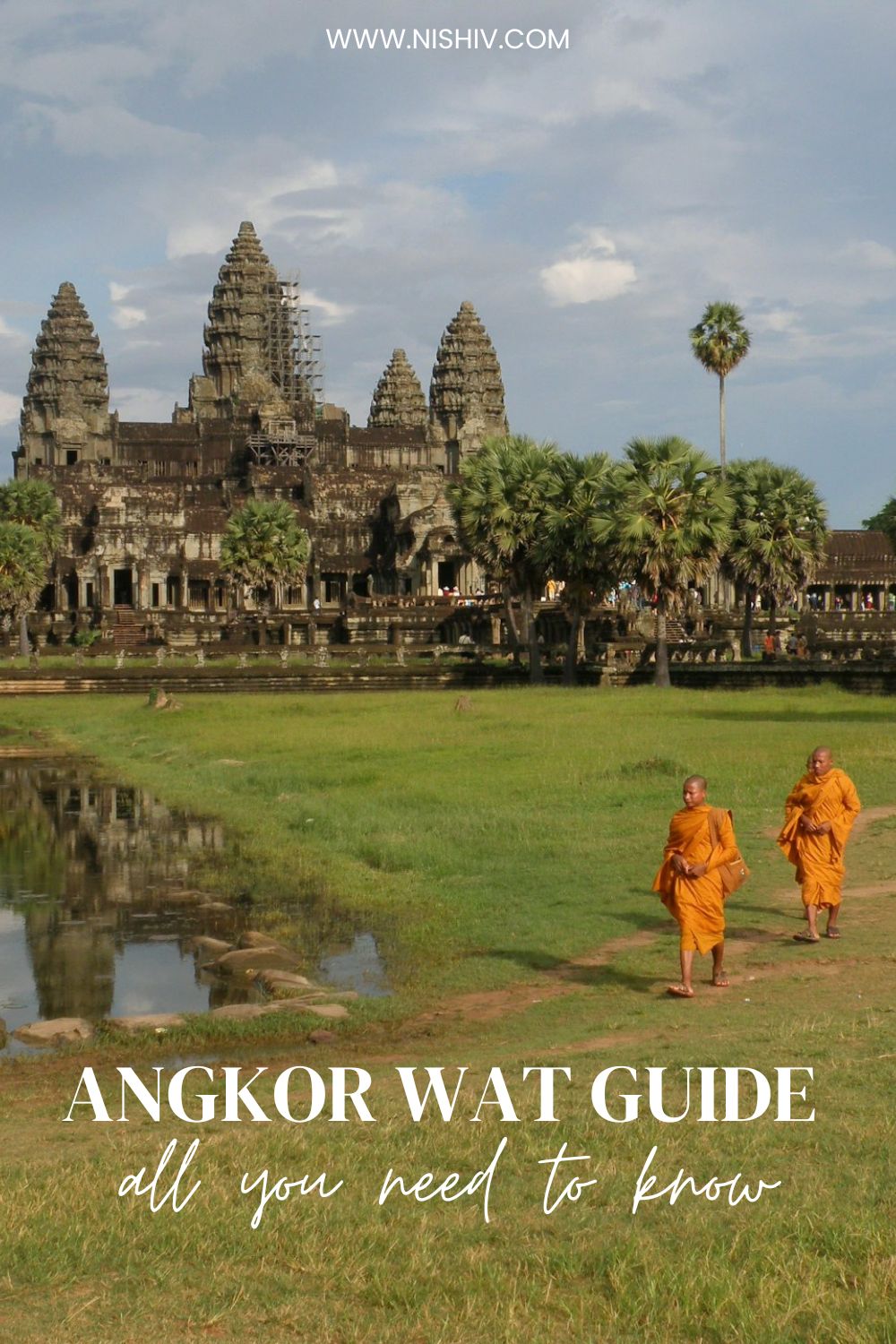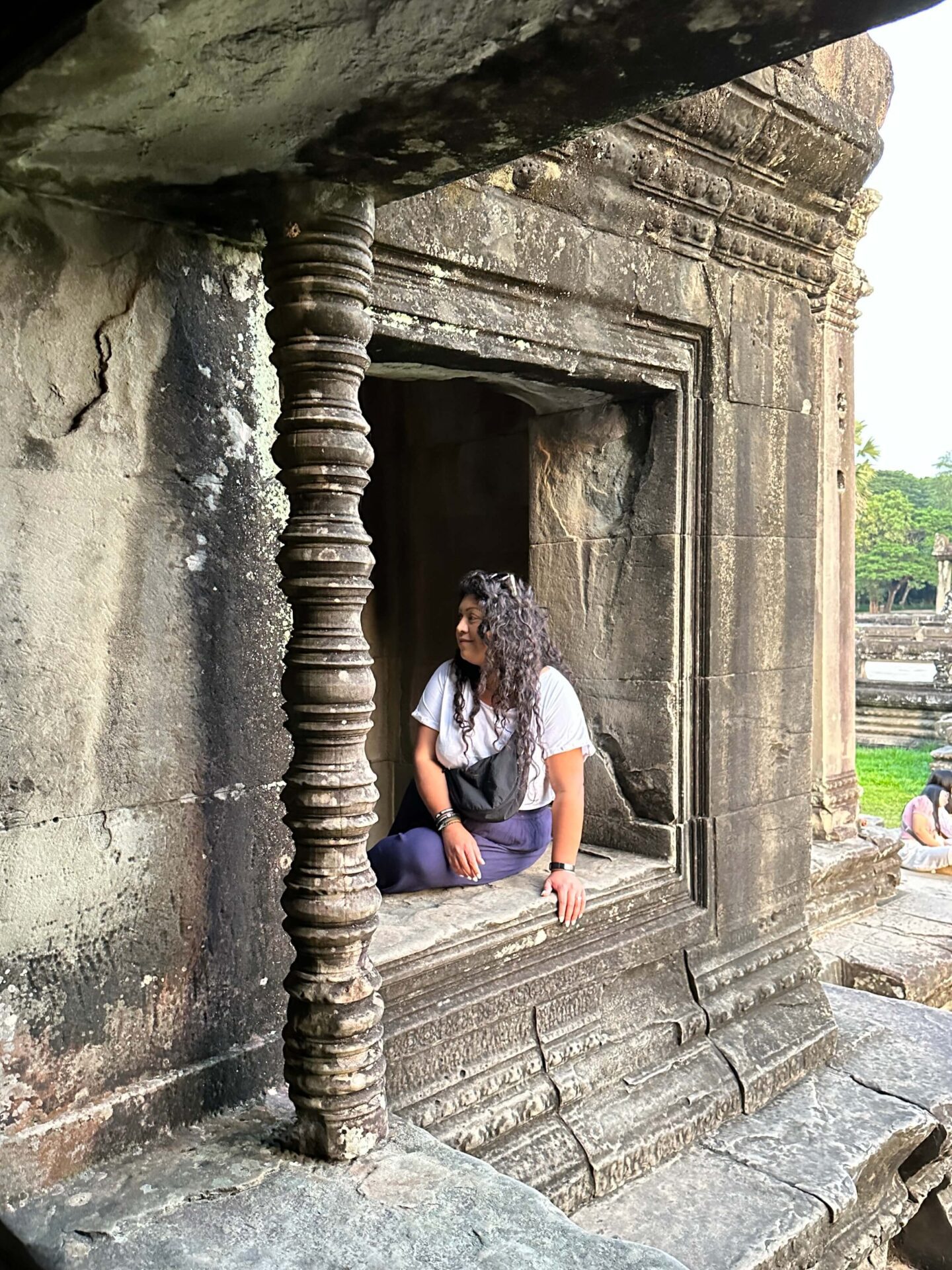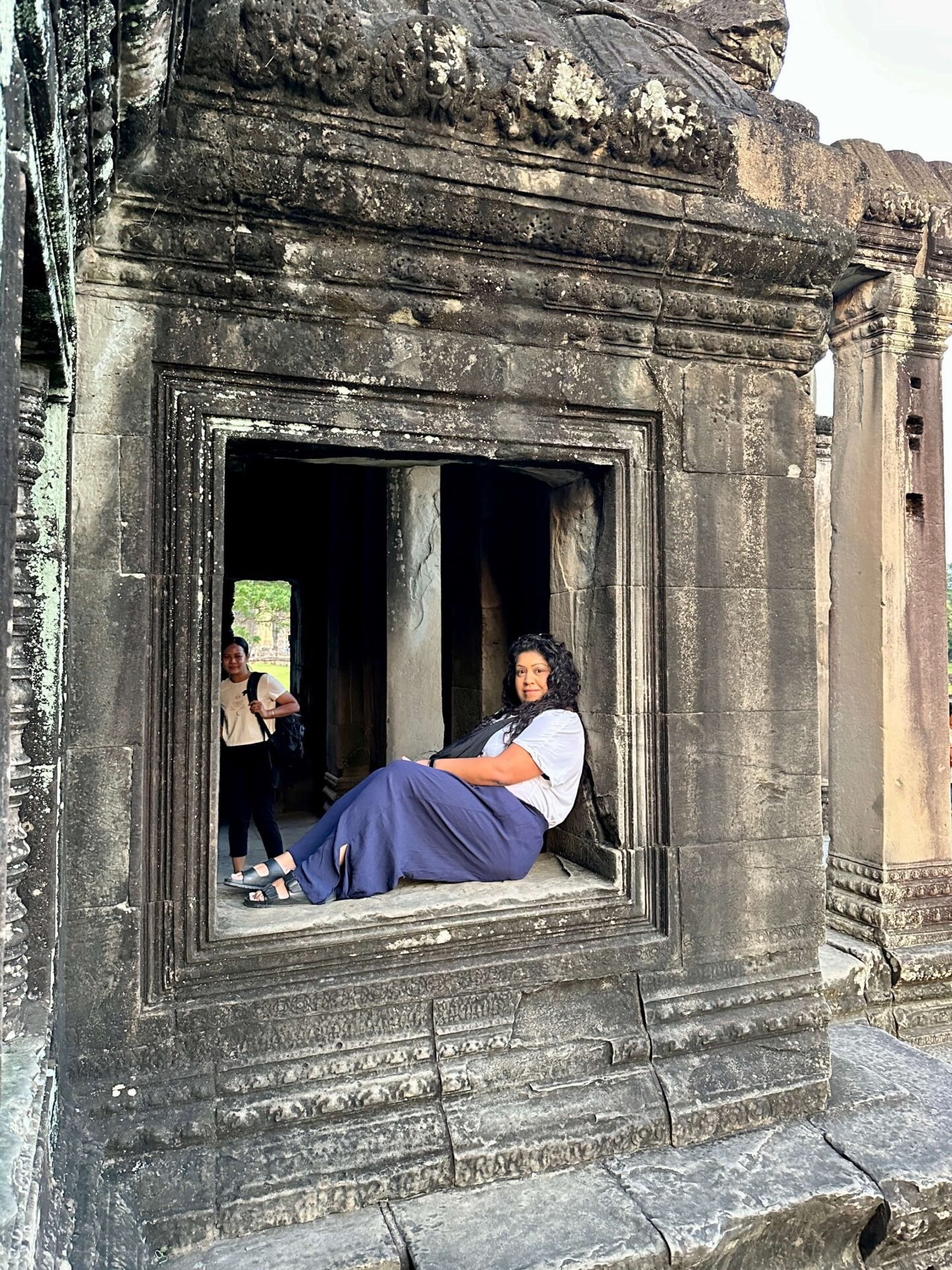Angkor Wat Guide – All You Need To Know Before Visiting Angkor Wat

Visiting Angkor Wat is one of those rare travel moments that will make you feel extremely insignificant – in a great way! Exploring the breathtaking ancient ruins will guarantee to make you feel simultaneously small and completely awestruck by the beauty that surrounds you.
One of the Seven Wonders of the World, Angkor Wat is the most famous ancient temple complex in Cambodia. Located in Siem Reap, this UNESCO World Heritage site is the crown jewel on most people’s Cambodia itinerary and for good reason – it is incredibly awe-inspiring.
This post may contain affiliate links which means that I may earn a small commission, at no extra cost to you, for qualifying purchases. For more information, read our disclaimer.
We visited Siem Reap for 3 days en route to Luang Prabang for this purpose alone. This alluring ancient wonder is an incredibly popular tourist attraction and if you have the opportunity to visit, I would highly encourage you to do so.
No time to read this post now? Pin it for later!


This Angkor Wat guide serves as a resource based on my personal experience from our trip, so read on to find out all you need to know before visiting Angkor Wat.


Visiting Angkor Wat: Everything you need to know
Angkor Wat is the world’s largest religious monument; the compound is over 162 hectares in size and houses several temple complexes. To call it vast would be an understatement.
From my firsthand experience, here are my top tips for visiting Angkor Wat.

Purchase an Angkor Pass in advance
Unless you are a Cambodian resident, you will need to purchase an Angkor Pass to visit the temples in Angkor Archaeological Park.
The pass can be purchased at the official ticket office just outside of Siem Reap town, but you’re likely to spend a lot of time queuing there and missing out on the experience itself.
Instead, I would recommend purchasing an Angkor Pass online, in advance. You simply download your ticket onto your phone, which can be shown either digitally or a physical printout at any checkpoint within the Angkor Park.
If you do decide to buy a ticket in person, bear in mind they only accept payment in either US Dollars, Cambodian Riel, Thai Bath or Euro.

Dress appropriately
As with all religious sites, you need to dress respectfully; ensuring that your shoulders and knees are covered. This means long trousers and tops with sleeves that cover your shoulders. Skirts, shorts, vest tops and other items of revealing clothing are not allowed within temple grounds.
You will cover a lot of ground, so comfortable shoes are also recommended. I wore a t-shirt tucked into some lightweight, flowy trousers and Birkenstock sandals.
Start your day early for sunrise

Starting your day early in the morning is a strategic move to beat the crowds and have the temple complex to yourself. The temples can get very crowded, especially during peak tourist seasons.
Arriving as early as 4 or 5am (depending on the time of year) will allow you to enjoy the temples with fewer crowds but most importantly, allow you to witness the stunning sunrise at Angkor Wat.
We noticed the complex start to become significantly busier once the sun had risen and the temples had officially opened. It really made us appreciate the calm tranquility of the early morning start.
Hire a guide


While you can wander around the temple complex on your own, hiring a local guide can enhance your experience by providing historical and cultural insights. You may appreciate the sites more if you have an understanding of the history as unlike in a museum, there are no information boards to read about the history or points of interest.
A guide can help navigate the temple complex and ensure you see the highlights. Alternatively, you can buy a guidebook all over Siem Reap but in my opinion, that isn’t as interesting.
Guides can be booked online, or they can be found wandering around at the entrance to Angkor Wat, and cost around $15-20 a day depending on the size of your group.
Stay hydrated
Angkor Wat is insanely hot all year round, so staying hydrated is essential to keep you going. Carry a bottle of water with you at all times. There are food vendors outside the complex, but it’s a bit of a walk away to find them depending on where you are.

Bring cash for drinks and snacks
Cash is king in Asia, so ensure you have some cash with you to buy any drinks or snacks throughout the day. I am not sure that any of the street food stalls accept card payment.
In all honesty, while there are food stalls and restaurants in the vicinity, bringing your own snacks is much better as it ensures you can continue exploring Angkor without interruptions. We didn’t need to purchase any food, but I did see that there are some vegetarian food options available around the site which is always useful to know.
Don’t forget the SPF
There aren’t many shady spots in and around the temples, so you will want to protect your skin from the sun with sunscreen, a hat and sunglasses to protect yourself from the sun.
Respect the temples
This should go without saying, but humans never fail to surprise me with their stupidity sometimes. Angkor Wat is a UNESCO World Heritage Site and holds significant cultural and religious importance.


With the growing number of visitors to this almost thousand-year-old monument, it is important to try and reduce the negative impact of our visits as much as possible by adhering to minimum standards of civility.
Respect the rules and regulations – do not climb on the temples or touch the carvings. You might be surprised at how many people attempt to take stone shards and other relics home with them – which of course, is prohibited.
Speaking of human stupidity..
Beware of the monkeys

Monkeys can be found throughout the Angkor complex; however, you must be cautious because they can bite. We witnessed a man trying to poke a monkey for fun (*insert eye rolling emoji*), which led to the monkey running after him to try and attack him – and rightly so!
If you have food or drinks in your hand, keep an eye on them as they possibly can steal them. They are so cute to observe from a distance though.
Explore beyond Angkor Wat
Angkor Wat rightfully takes centre stage as the mega-temple, having stood the test of time in the Khmer Empire. However, the surrounding temples now constitute Angkor Archaeological Park, offering a number of remarkable temples that also deserve your attention.
Angkor Thom, for example is the actual metropolis and site of the royal palace.


With its enigmatic smiling faces carved into towering stone structures, Bayon is also a sight to behold. The intricate details and symbolic significance of these stone faces will leave you in awe and ignite your curiosity about the ancient Khmer civilisation.
The neighbouring temples each showcase their unique charm and architectural splendour.

Ta Prohm is the iconic temple that has been left to nature throughout the years and the trees have most definitely taken over. The roots of these trees snaking between rocks and huge trunks erupting through the walls is incredible to see. Particularly how enormous trees have managed to grow across stone.
Fun fact – the Tomb Raider movie starring Angelina Jolie was filmed there.
Take your time



Don’t rush through the temples. Take your time to admire the intricate carvings, explore hidden corners, and soak in the ambiance. Angkor Wat is not just about ticking off landmarks but about experiencing a profound sense of history and spirituality.
Witness the serene beauty of Angkor Wat as monks stroll through the ancient ruins in groups. Many of these are tourist monks and they do exactly what any of us would do — admire the ruins of the temple and and pose for lots of photos.
Be prepared for crowds of people

When visiting Angkor Wat, you must be prepared for crowds. As one of the world’s most renowned tourist destinations, it attracts visitors from all around the globe – approximately 2.6 million visitors a year to be precise.
It will be crowded, everywhere – you just need to be prepared for that, particularly if you’re trying to take photos.
Don’t miss the sunset
Just as the sunrise is spectacular, so is the sunset. You can book a sunset tour or simply find a quiet spot to watch the sun dip below the horizon, casting a warm glow over the ancient temples.
Golden hour always makes for another great time of day to take photos too!
Hopefully these Angkor Wat tips help you plan your visit and make the most of your time at the majestic Angkor Wat.
How To Visit Angkor Wat
Siem Reap, Cambodia is the main entry point to the Angkor Archaeological Park. You can either fly in via Siem Reap International Airport or take a bus from Phnom Penh or Bangkok, Thailand.
The streets of Siem Reap are crawling with drivers who want to take your business, so you certainly won’t struggle finding either a car or tuk-tuk driver. You can hire them to take you on a whole-day temple tour, starting at Angkor Wat and then Bayon, Phnom Bakheng, Ta Prohm and more.
Hiring a tuk-tuk driver for the day costs around $20 a day and a driver with a car $30 per day. We paid $30 for a driver with a car, and let me tell you we seriously appreciated the air conditioning in between the temple hopping!
While you can hire a moped and make your own way there, it isn’t the same as someone who knows where they are going. The driver waits for you all day and you are free to take as much or as little time as you want.
Walking between the sites is not advised as the temples in this list are scattered over two hundred hectares of Siem Reap real estate.
This small-group sunrise tour is really affordable and the most affordable way to join a group tour.
How to plan your day at Angkor Wat
Once you have your driver secured, they will advise you on the best time to pick you up (depending on the time of the year and what time the sun rises).


If you haven’t bought your temple pass in advance (I recommend that you do), they will then take you from your hotel to the ticket office, which is about a 5 minute drive from the temple grounds. There are known to be long queues here.
Tickets are checked on the drive to the temple, and you will be dropped off at the main star of the show, Angkor Wat first. There is a significant walk from the drop off point up to the complex, and though not well-lit, it’s stunning as the sun begins to rise and the first peek of morning light begins to emerge.
Your driver will transport you from one temple to the next, waiting for you outside each one until you’re finished and ready for the next! Or until you start to experience ‘temple fatigue’ – a very real thing that happens to many people in Southeast Asia.
Best time of year to visit Angkor Wat
The rainy season in Cambodia falls between May and October. The temples will be much less crowded around this time, but of course you’ll have a higher chance of rainfall.

Peak temperatures are around March – May, with highs of 35 degrees celsius, so you may find it more tiring to walk around all the temples in the midday heat.
We visited in November, narrowly missing rainy season and it was ideal. The temperature was quite chilly early in the morning, but it certainly started to warm up as the day went on with zero rain.
How much does Angkor Wat cost to visit?
There are 3 ticket options for Angkor Wat:
- $37 for a 1-day pass
- $62 for a 3-day pass
- $72 for a 7-day pass.
I would recommend buying your Angkor Pass online. The pricing encourages tourists to spend longer visiting the temples.
There are various checkpoints throughout the complex and hefty fines for people without valid tickets, so make sure you have an e-ticket saved on your phone to produce at any given moment – it just makes it harder to lose that way.
Once you have purchased your tickets, you might want to book a sunrise tour in advance. This option is great for solo travellers and includes hotel pick-ups too.
How many days do you need to see Angkor Wat?
We chose the single 1 day pass as we only had two full days in Siem Reap, but would opt for the 3 day pass if we return. I personally think 7 days is unnecessary.
The question that most people ask is how many days does it take to see these magnificent ruins and can you truly see them all in just one day?
The short answer is not fully.
It is possible to see the highlights of Angkor in one or two days, but three days means you’re not rushing around and you get to enjoy your experience a bit more. You will also get to see some of the more remote temples and sites if you spend longer exploring.
However, if money or time are constraints, then you can definitely see the main temples in just one day. Bear in mind that you won’t see them all and you will be slightly rushing around throughout the day.

Is Angkor Wat really worth visiting?
Absolutely, yes.
A visit to Angkor Wat is a pilgrimage to an architectural masterpiece and a given for any discerning travellers’ bucket list. Contrary to what people say, sunrise is most definitely the best time to visit and well worth the 4am alarm!
Walking through its colossal ruins, you can practically feel the history seeping through the stones. A truly spectacular experience that was the highlight of our short time in Siem Reap.
Can you visit Angkor Wat without a guide?
Yes – you do not need to pay for a guide when visiting Angkor Wat.
This is down to personal preference. Whether you’re on a budget or simply not as keen to learn about the history of the temple complex in detail, your pass allows you to wander around the grounds independently.
It is very easy to locate a guide on the day if you change your mind – we had numerous people offering us tours throughout the day.
Can you walk around Angkor Wat?
You will walk around the actual Angkor Wat temple as this is the only way to see it.

However, you will probably struggle with walking from temple to temple, and likely won’t fit in as much as you could into one day. For example, walking from the entrance of Angkor Wat to the next large temple, Bayon Temple is a 45 minute walk. This doesn’t take the heat and humidity of Siem Reap into consideration either.
So yes, it is walkable but you’ll likely be very tired by the end of the day.
Where to stay when visiting Angkor Wat
If you’re only in Siem Reap for a short time, and want to be in close proximity to Angkor Wat and the the other sites, I would recommend staying at Borei Angkor Resort & Spa.


We spent 3 nights at this luxury resort and location wise, this was perfect. Just a 10 minute drive to Angkor Wat, 5 minutes drive to Siem Reap downtown for all the good local restaurants, infamous Pub Street, Angkor Night Market and other nearby local attractions in Siem Reap.
Check here for a list and the latest prices of where to stay in SIEM REAP, Cambodia.
Hopefully this Angkor Wat travel guide provides you with valuable insights and guidance for your upcoming adventure. Whether you’re a culture seeker, a history enthusiast or simply seeking out magnificent architectural marvels, Angkor Wat has all the majestic allure.
If you are visiting Angkor Wat, pin this post for later!


Read more about Cambodia:
Need help planning your trip from start to finish?
Check out these helpful links:
- Find cheap flights
- Savings on accommodation from boutique hotels to affordable resorts
- The most comprehensive resource to help plan excursions on your next trip
- Want free lounge access? This pass gives you access to over 1500 airport lounges for free
- Affordable car rental options
- Compare and book land and water transport for travelling around South East Asia
- Use an eSIM to prepare your phone for international travel before leaving the house
- Pay anywhere in the world, in any currency, using your debit card without paying a fee
- Don’t forget! Travel insurance with essential medical and travel coverage at low premiums






